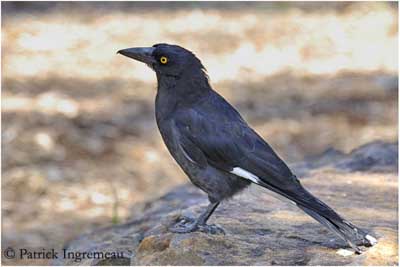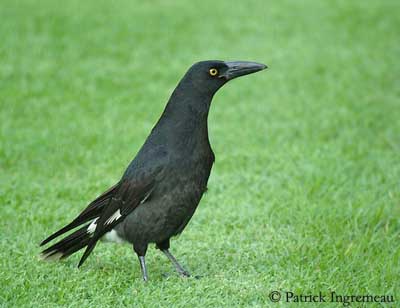
Pied Currawong
Strepera graculina
Passeriforme Order – Cracticidae Family
BIOMETRICS :
Length : 44-51 cm
Weight : 285 g
DESCRIPTION:
Pied Currawong is a large black and white bird.
Adult male has black plumage overall, except white patches on under tail, on tips and bases of tail feathers, and also small white patch near wing tips (mainly visible in flight).
Head is black. Powerful, long bill is black. Eyes are yellow. Legs and feet are blackish.
PROTECTION / THREATS / STATUS:
Pied Currawong’s populations have increased with changes in the habitat by human developments.
Pied Currawong is a strong nest predator and kills numerous broods of small birds. But it is not the only one, and it is difficult to determine which predator preyed on a nest.
Some attempts for control of Pied Currawongs have been made, in order to stop declines in other bird species. One of the solutions is to reduce the quantities of introduced exotic plants producing berries eaten by these birds.
Fr: Grand réveilleur
All : Dickschnabel-Würgerkrähe
Esp : Currawong Pálido
Ital : Cornacchia sibilante bianca e nera
Nd : Bonte Klauwierkraai
Russe : Пегий курравонг
Photographs by Patrick Ingremeau
His website : TAMANDUA
Text by Nicole Bouglouan
Sources:
Welcome to the Australian Museum
Birds in backyards (Birds Australia and Australian Museum)
Wikipedia (Wikipedia, The Free Encyclopedia)

Both sexes are similar, but female may have greyer underparts.
Juvenile is duller and browner than adults, and it has black eyes.
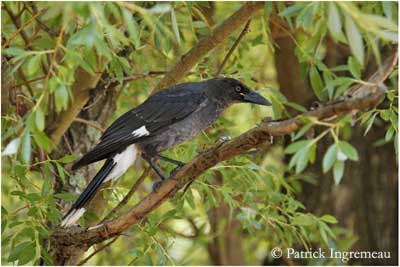
We can find six subspecies: S.g. graculina; S.g. ashbyi; S.g. crissalis; S.g. magnirostris; S.g. robinsoni; S.g. nebulosa.
VOICE: SOUNDS BY XENO-CANTO
Pied Currawong utters beautiful melodious calls. These rolling sounds are loud and ringing, and the most common call is described as “currawong”, giving the bird its English name. Pied Currawong may also utter deep croaks and high-pitched whistles as wolf’s calls when perched.
HABITAT:
Pied Currawong lives in wooded areas such as forest and woodlands. It is common in urban areas where it is well adapted. It is also found in farms, gardens and scrublands.
RANGE:
Pied Currawong lives in the east of Australia, from northern Queensland to Victoria.
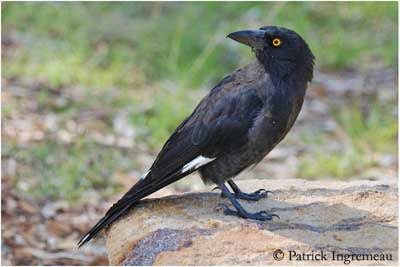
BEHAVIOUR:
Pied Currawong hunts mainly in trees and on the ground, searching for wide variety of food, such as lizards, insects and berries. It also may take small birds in their nests. During winter, it hunts in urban areas, feeding on berries and small vertebrates.
Pied Currawong may take larger preys, and birds of this species can also hunt as a group. It can use a “larder”, storing some preys by hanging them on spines as hooks, but also in tree forks or in crevices. In some areas, Pied Currawong seeks food from people.
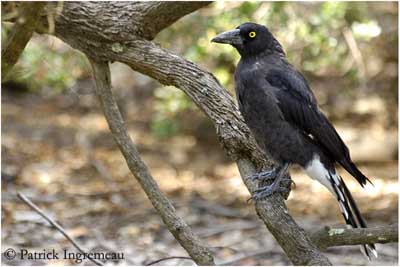
They are gregarious and have large communal roosts.
Pied Currawong is mainly seen alone, in pairs or in family groups. Outside the breeding season, they can form large flocks and they move long distances in autumn and winter. Northern populations are rather resident in their area than southern birds which move from their higher areas to lowlands in colder regions.
Pied Currawong is considered as nest predator, and has negative influence on smaller species in some areas of its range. They now remain in cities all year round, finding there important food resources.
During breeding season, pairs defend the nest-site and surrounding territory where they find food for their young.
FLIGHT:
Pied Currawong has white patches close to wing tips, mostly visible in flight.
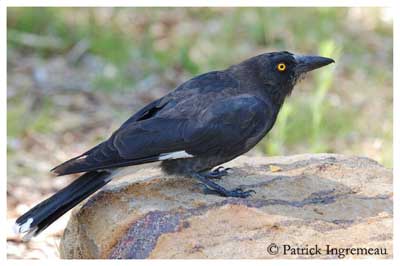
REPRODUCTION:
Breeding season occurs from July to November in the north, and from September to January in the south.
Pied Currawong breeds now more in lower areas than tablelands and higher habitats. Introduction of exotic plants provides them food resources at any time of the year, and encourage them for breeding at lower elevation.
Nest is usually built high in tree, on branch under foliage. Both sexes collect nest materials, but female builds the nest in about two weeks.
It is a large platform made with sticks and twigs. Interior is lined with softer vegetation.
Female lays 2 to 4 spotted eggs. Incubation lasts about 20 to 21 days, by female. Male feeds her during this period.
Young are fed by both parents during one month before they fledge. They remain several months with parents after fledging, and are fed by them.
Nest may be parasitized by some Cuckoos species.
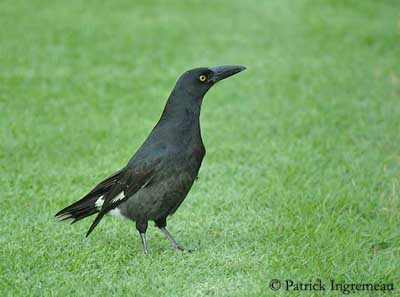
DIET:
Pied Currawong is omnivorous, hunting in varied kinds of areas, and eating wide range of food.
It feeds on insects, fruits and vertebrates such as small and young birds. It also eats small lizards, snails, caterpillars and berries. It often scavenges and seeks food from people.
